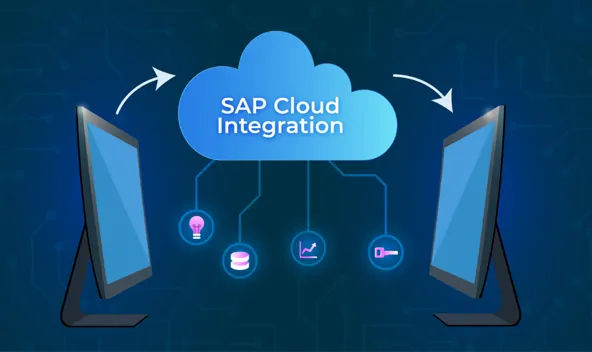What Is SAP Cloud Integration?
SAP Cloud Integration connects cloud and on-premise apps, enabling seamless data flow and process automation across diverse systems.

Introduction
SAP Cloud Integration is a key component of the SAP Integration Suite, designed to connect disparate systems seamlessly across cloud and on-premises environments. It facilitates real-time data synchronization, supports various integration scenarios, and reduces IT complexity through pre-built adapters and content. By providing scalable and flexible solutions, SAP Cloud Integration enhances operational efficiency, data accuracy, and overall business agility, while ensuring robust security and compliance.
Everything You Should Know About SAP Cloud
SAP Cloud is a comprehensive suite of cloud-based solutions from SAP, designed to support various business processes and industries. Its key offerings include SAP Business Technology Platform (BTP), which integrates data management, analytics, and application development; SAP S/4HANA Cloud, an enterprise resource planning (ERP) solution for real-time business processes; and SAP SuccessFactors for human capital management.
SAP Cloud solutions aim to enhance flexibility, scalability, and efficiency for businesses by leveraging cloud infrastructure. They offer benefits like reduced IT costs, faster deployment times, and access to advanced technologies such as artificial intelligence and machine learning. Aspiring SAP professionals must consider joining the SAP Online Course for the best skill development and opportunities in this field.
Additionally, SAP Cloud provides robust security features to protect data and ensure compliance with global regulations. Overall, SAP Cloud helps organizations streamline operations, drive innovation, and respond agilely to market changes.
What Is SAP Cloud Integration?
SAP Cloud Integration is a component of SAP's Integration Suite that facilitates seamless connectivity between SAP and non-SAP systems, both on-premises and in the cloud. It enables organizations to integrate various applications, data sources, and processes across different environments, ensuring smooth data flow and consistency.
Its key features include pre-built integration content, adapters, and connectors that simplify the integration process and reduce development time. SAP Cloud Integration supports various integration patterns, such as process integration, data integration, and API management, allowing businesses to tailor solutions to their specific needs. It also offers real-time data synchronization and transformation capabilities, ensuring that information is up-to-date and accurate.
With its cloud-based architecture, SAP Cloud Integration provides scalability, flexibility, and reduced infrastructure costs, helping organizations optimize their IT landscape and improve overall operational efficiency.
How Is What Is SAP Cloud Integration Done?
SAP Cloud Integration is performed through a series of steps that leverage the SAP Integration Suite to connect disparate systems.
Here's an overview:
1. Define Integration Scenarios: Identify the systems and data flows that need integration. This includes understanding business processes and determining which applications will interact.
2. Configure Integration Flow: Use the SAP Integration Suite’s Integration Flow Designer to create and configure integration flows. This involves setting up data mapping, transformation, and routing rules. The Integration Flow Designer provides a graphical interface to design these processes.
3. Set Up Adapters: Choose and configure appropriate adapters for different systems. SAP Cloud Integration supports various adapters, including those for REST, SOAP, and IDoc protocols. For example:
“<Adapter>
<Name>HTTP</Name>
<Type>Sender</Type>
</Adapter>”
4. Deploy and Monitor: Deploy the integration scenarios to the SAP Cloud Integration runtime environment. Additionally, monitor the integration processes using the SAP Integration Suite’s monitoring tools to ensure that they operate smoothly.
5. Test and Optimize: Test the integration flows to verify functionality and performance. Optimize configurations based on testing outcomes and operational feedback.
6. Manage Security and Compliance: Ensure that data transmission adheres to security protocols and compliance requirements. Implement necessary encryption and authentication measures.
SAP Cloud Integration leverages these steps to ensure efficient, secure, and effective connectivity across diverse systems and platforms. Consider investing in the SAP Online Course for the best guidance in SAP.
Why Is SAP Cloud Integration Important?
SAP Cloud Integration is crucial for several reasons:
· Seamless Connectivity: It enables smooth integration between SAP and non-SAP systems, both cloud-based and on-premises. This connectivity ensures that disparate systems can share data and processes effectively, enhancing operational efficiency.
· Real-Time Data Synchronization: By facilitating real-time data integration, SAP Cloud Integration ensures that information across systems is current and accurate. This helps in making timely, informed business decisions.
· Scalability and Flexibility: The cloud-based nature of SAP Cloud Integration allows businesses to scale their integration needs according to growth and changing requirements. It supports various integration scenarios, from simple data transfers to complex process automation.
· Reduced IT Complexity: Pre-built integration content and adapters simplify the integration process, reducing the need for custom development and minimizing IT complexity. This accelerates deployment and lowers costs.
· Enhanced Agility: Businesses can quickly adapt to new market conditions, technologies, or business requirements by leveraging flexible integration solutions. This agility is vital in a fast-paced digital landscape.
· Improved Compliance and Security: SAP Cloud Integration incorporates robust security features to protect data during transit and ensure compliance with industry regulations, safeguarding sensitive business information.
Overall, SAP Cloud Integration is essential for optimizing IT landscapes, driving operational efficiency, and supporting business agility in a connected world. Aspiring SAP professionals can check the SAP Certification List and join a training program that suits them the best.
Conclusion
In summary, SAP Cloud Integration is vital for ensuring seamless connectivity between diverse systems, enhancing data accuracy, and enabling scalability. It simplifies integration, reduces IT complexity, and supports real-time decision-making while maintaining robust security and compliance. These benefits collectively drive operational efficiency and business agility.
What's Your Reaction?














